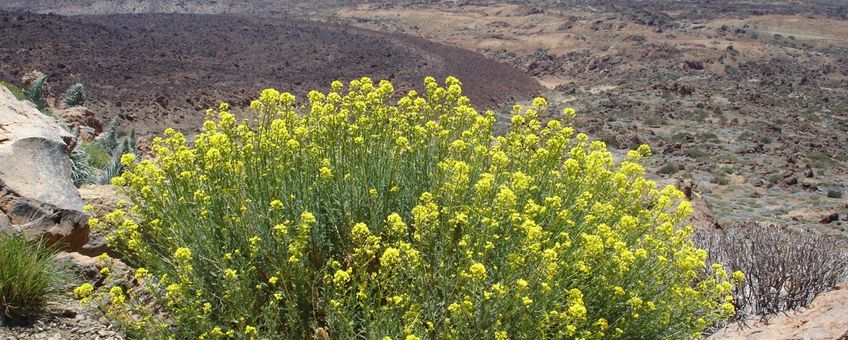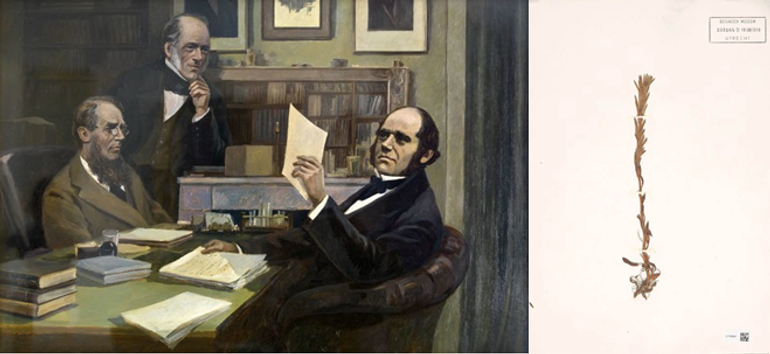
Nineteenth century plants used in new research
Naturalis Biodiversity CenterOn September 30, 1839, a young British botanist left on an expedition that could no longer be realized today. It would be the last great voyage of discovery by sailing ship, in search of the magnetic South Pole. No one on board the two ships knew exactly what they would encounter. If you were to travel to the moon or even to Mars today, you would know more about your destination than these people did back then. The 23 year old botanist, Joseph Dalton Hooker, was the youngest on board.
Hunting plants
That Saturday, he had no clear idea about how long he would be away for – it ended up being almost four years. He scarcely knew that Antarctica was a continent and that the magnetic South Pole could therefore not be reached by boat. And that this expedition would still be relevant for biology more than 180 years later, is something that he possibly did not anticipate either.
On the way, Hooker collected and drew every single plant he could lay his hands upon. And after his return, he spent another sixteen years producing a six-volume book series about it. Later, he would become the director of the Royal Botanic Gardens in Kew, inspire his best friend Charles Darwin to write On the Origin of Species, and go on more botanical voyages of discovery. However, for this present story, all those details are less relevant than his plant collection.
Hooker’s dried plants, stored on so-called herbarium sheets, eventually ended up in the collection of Naturalis. Here, researchers Kasper Hendriks and Frederic Lens are extremely pleased with the 180-year-old dried plants. "It is a collaboration across the generations," Hendriks jokes.

Big family
Hendriks and Lens have been working on reconstructing the evolutionary tree (what scientists call a phylogeny) of the Brassicaceae family since December 2019. This plant family is found throughout the world. For decades it has been of significant importance within biology, especially because one of the members of the family, the thale cress (Arabidopsis thaliana), is an important model organism. Many vegetables that we cultivate and breed on a large scale also belong to this Brassicaceae family. Broccoli, cabbage, radish, arugula (rucola), mustard, and wasabi are plants we eat; wallflower, common stock, and honesty are flowering plants we cultivate; and then there are about 4000 wild species.
Such a phylogenetic tree could form a valuable tool for the hundreds of scientists around the world who work on this plant family, for example to determine the relationships between species or how interesting traits evolved. Lens, for instance, is interested in the role of wood formation in the evolution of this plant family - something that is not only interesting from an evolutionary biology point of view, but also relevant for the cultivation of crops that are more drought-resistant. Nevertheless, no complete family tree has been available yet because of the family’s considerable size. Furthermore, the relationships are difficult to reconstruct because many species that are not closely related nevertheless exhibit very similar characteristics. In those cases, the differences in DNA sequences between species can help, because these usually provide reliable information about the relationships.
The family tree must therefore be built using DNA data. For most of the species in the research, more than one thousand genes have been included, an unprecedentedly large number compared to the two to five genes that were previously investigated. Thanks to new techniques and the well-equipped laboratories of Naturalis, Hendriks and Lens could rapidly scale up their research.

Entire family tree
The new techniques also meant it was possible to extract DNA on a large scale from the leaves of old, dried plants, something that was previously exceedingly difficult. To illustrate this: in the new research, about ten percent of the used dried plants were collected before 1900, whereas previously, plants more than twenty years old were considered to be ‘too old’ and therefore avoided for further DNA research. Thanks to the new techniques, the researchers could tap into rarer and less accessible plant species in their study than was previously possible. Therefore, some of the plants that Hooker collected around 1840 in the Falkland Islands in the South Atlantic Ocean could be used too. The oldest sample used in the research was a white cabbage (Sinapis alba) of unknown origin collected and dried in 1807.
To obtain all these Brassicaceae species, the biologists requested samples of dried plants from more than thirty other herbariums located around the world. That was convenient to do during the COVID-19 pandemic, because colleagues on the other side of the world only needed to send dried leaves by post and there was no need to travel.
At the start of 2022, Hendriks and Lens will submit the most complete and accurate family tree of the Brassicaceae family ever for publication together with researcher Klaus Mummenhoff from Osnabrück University in Germany, one of the initiators of the project. For the first time, this family tree will contain species from nearly all 350 or so genera that the family contains. Hendriks: "The next version, which is planned for the summer of 2022, will contain more than one thousand species. That is a large and crucial step towards a complete family tree."
More information
Text: Kasper Hendriks, biologist at Naturalis Biodiversity Center
Photos: Naturalis Biodiversity Center (lead photo: Descurainia bourgaeana by Frederic Lens); Kasper Hendriks
